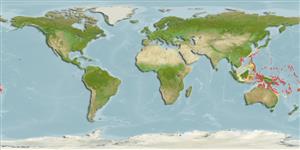Environment: milieu / climate zone / depth range / distribution range
Ecology
Marine; reef-associated; depth range 5 - 25 m (Ref. 34024). Tropical
Western Central Pacific: Great Barrier Reef north of 16°S and in Papua New Guinea south of 5°S; westwards in Maluku, Indonesia; along the Louisiade Archipelago to the Solomon Islands including Santa Cruz Islands and Vanuatu.
Size / Weight / Age
Maturity: Lm ? range ? - ? cm
Max length : 10.3 cm SL male/unsexed; (Ref. 57884); 10.0 cm SL (female)
Dorsal soft rays (total): 74 - 85; Anal soft rays: 60 - 69; Vertebrae: 43 - 45. The species is characterized by the following: vertebrae 11+32-34=43-45, dorsal fin rays 74-85 (mostly >77), anal fin rays 60-69, D/V 6 (rarely 7); large eyes (2.1-3.4% SL); outer pseudoclasper with broad hook-shaped extension, with rounded tip, slightly bent outwards; inner pseudoclasper short, joined to outer pseudoclasper anteriorly, supporter with anteriorly oriented small hook, and with a wide thin flap at posterior-distal margin; scale patch on cheek with 7-9 scale rows on upper cheek, many scales on operculum above opercular spin (7-16 scales in 2-4 rows), in very large specimens additional scale patch below opercular spine (4-12); head profile is moderately slender; otolith length sulcus length 1.9-2.0, sulcus slightly inclined (Ref. 57884).
Rare species, found on coral-sand bottom (Ref. 34024). Benthic (Ref. 75154). Cryptic and solitary (Ref 90102).
Life cycle and mating behavior
Maturities | Reproduction | Spawnings | Egg(s) | Fecundities | Larvae
Schwarzhans, W., P.R. Møller and J.G. Nielsen, 2005. Review of the Dinematichthyini (Teleostei, Bythitidae) of the Indo-West-Pacific. Part I. Diancistrus and two new genera with 26 new species. The Beagle, Records of the Museum and Art Galleries of the Northern Territory 21:73-163. (Ref. 57884)
IUCN Red List Status (Ref. 130435)
Threat to humans
Harmless
Human uses
Fisheries: of no interest
Tools
Warning: mysqli::__construct(): (HY000/1040): Too many connections in /var/www/html/includes/speciessummary.lib.php on line 2104
Can't connect to MySQL database fbquizv2. Errorcode: Too many connections
